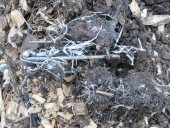posted 4 years ago
My hugel beet ( one word, or two, I'm not sure I have seen both). Is kind of like a cross between a raised bed and a hugelkultur. I dug down 2 feet. Basically I have a hole 2 feet deep, 3' 3" wide and about 8' Long. I put the largest wood I have in the bottom. This is where you would put logs if you had them. I don't so I used old fire wood, and some large chunks of a walnut branch that fell last year. I covered that with native soil ( what I dug out of the hole). Then I did a layer of medium wood like branches and small wood. Then a layer of stuff to be composted I will call it, stuff like leaves, food scraps, bark, twigs, tomato vines and dead flower stalks, shredded cardboard, stuff like that. Topped with native soil, wood chips, native soil, wood chips, native soil (I normally only do one layer of wood chips, but I wanted to get it to a certain level so I wouldn't have to buy any soil. Then I added all the soil from the raised bed I was replacing. Then I had a 3 cubic foot bag of organic garden soil, 1 and a half bags of organic compost, 1/3 of a bag of organic chicken manure, and mushroom compost. All of which I had on hand. Once I got all this in I mixed it together. The reason I use stuff I did buy at some point is because my soil has a lot of clay in it, so veggies do better with help. I used concrete blocks around the hole two high giving me a 3' depth.
I live in California zone 9b. I have only been using this type of raised bed for about a year, and I can't tell you how much difference it has made. It is the best change I have ever made. Things grow better, I water way less. It's a ton of work to make, but very worth it. My goal is to eventually convert all of my raised beds to hugel beets. I detailed my HB because I'm not sure it follows the exact definition of a Hugel beet. It's what I do and is working for me. I actually had two tomato plants and 3 pepper plants that are still alive that I planted last spring. I don't know if they will produce, but I'm excited to find out. I know the very mild winter we had has a lot to do with it, but we have had mild winters before, and I have never had a warm weather plant live through the winter. Sorry for the long explanation.
“We can complain because rose bushes have thorns, or rejoice because thorn bushes have roses.” — Abraham Lincoln






